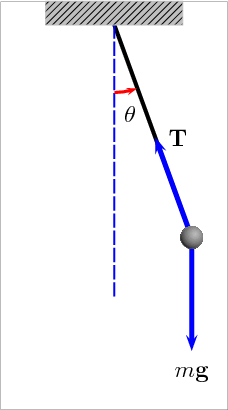Pendulum Motion: Difference between revisions
| Line 10: | Line 10: | ||
===Properties of Pendulum Motion=== | ===Properties of Pendulum Motion=== | ||
[[File:penduloTmg.gif|thumb| Animation of a pendulum showing | [[File:penduloTmg.gif|thumb| Animation of a pendulum showing | ||
| Line 17: | Line 16: | ||
gravitational force mg. [https://en.wikipedia.org/wiki/Pendulum Link]]] | gravitational force mg. [https://en.wikipedia.org/wiki/Pendulum Link]]] | ||
A pendulum is just a mass hanging from a spring moving back and forth. In order to describe a pendulum, you need to understand its properties and parameters. There is a string with length '''L''', a mass '''m''' hanging from the string, and it is pulled away from its equilibrium, there is an angle measured off the vertical. The two forces acting on the pendulum when it is pulled away from its equilibrium are the string tension, '''Ft''' and the gravity, '''F = mg'''. | A pendulum is just a mass hanging from a spring moving back and forth. In order to describe a pendulum, you need to understand its properties and parameters. There is a string with length '''L''', a mass '''''m''''' hanging from the string, and it is pulled away from its equilibrium, there is an angle measured off the vertical. The two forces acting on the pendulum when it is pulled away from its equilibrium are the string tension, '''Ft''' and the gravity, '''F = mg'''. | ||
[[File:pendulum.gif]] | [[File:pendulum.gif]] | ||
===Period of Oscillation=== | ===Period of Oscillation=== | ||
Revision as of 00:04, 4 December 2015
--mbriatta3 (talk) 14:17, 3 December 2015 (EST)
The pendulum is a mass hanging from a string of negligible mass that is fixed to a point. The equilibrium position of the pendulum is the position when the string and mass hang vertically downward. When pulled back away from this equilibrium state, the string and mass will swing back and forth. If there is no friction or air resistance applied then the pendulum will swing forever.
The Main Idea
Electric Field of Capacitor
Properties of Pendulum Motion

A pendulum is just a mass hanging from a spring moving back and forth. In order to describe a pendulum, you need to understand its properties and parameters. There is a string with length L, a mass m hanging from the string, and it is pulled away from its equilibrium, there is an angle measured off the vertical. The two forces acting on the pendulum when it is pulled away from its equilibrium are the string tension, Ft and the gravity, F = mg.
Period of Oscillation
Energy
Velocity
A Computational Model
Animation of a pendulum showing the velocity and acceleration vectors. Link
Examples
Be sure to show all steps in your solution and include diagrams whenever possible
Simple
Middling
Difficult
Connectedness
Talk about clocks
As you see, the pendulum motion can be seen in our everyday life. As an architecture major, I have always been interested art and design. Different sculptures, installations, and art pieces can even be achieved throughout the application of a pendulum motion. Take a look here and here and here
History
Put this idea in historical context. Give the reader the Who, What, When, Where, and Why.
See also
- Barton's Pendulums
- Double Pendulum
- Pendulum Clock
- Pendulum (mathematics)
- Spherical Pendulum
- Simple Harmonic Motion
Further reading
- G. L. Baker and J. A. Blackburn (2009). The Pendulum: A Case Study in Physics (Oxford University Press).
- M. Gitterman (2010). The Chaotic Pendulum (World Scientific).
- Michael R. Matthews, Arthur Stinner, Colin F. Gauld (2005)The Pendulum: Scientific, Historical, Philosophical and Educational Perspectives, Springer
- Michael R. Matthews, Colin Gauld and Arthur Stinner (2005) The Pendulum: Its Place in Science, Culture and Pedagogy. Science & Education, 13, 261-277.
- Schlomo Silbermann,(2014) "Pendulum Fundamental; The Path Of Nowhere" (Book)
- Matthys, Robert J. (2004). Accurate Pendulum Clocks. UK: Oxford Univ. Press. ISBN 0-19-852971-6.
- Nelson, Robert; M. G. Olsson (February 1986). "The pendulum – Rich physics from a simple system". American Journal of Physics 54 (2): 112–121. Bibcode:1986AmJPh..54..112N. doi:10.1119/1.14703.
- L. P. Pook (2011). Understanding Pendulums: A Brief Introduction (Springer).
External links
References
- Chabay, Ruth W., and Bruce A. Sherwood. Matter and Interactions. Hoboken, NJ: Wiley, 2011. Print.
- "Pendulum Motion." Pendulum Motion. Physics Classroom, 1996. Web. 03 Dec. 2015.
- "Pendulum." Wikipedia. Wikimedia Foundation, n.d. Web. 03 Dec. 2015.
